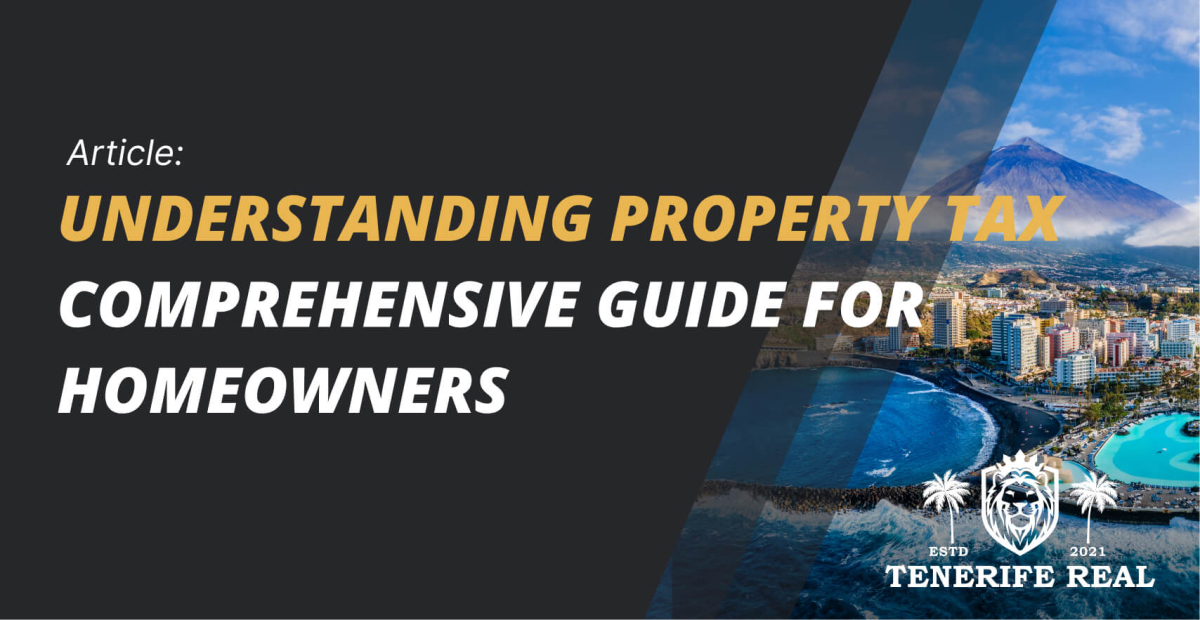
Understanding Property Tax in Tenerife
Understanding Property Tax in Tenerife: A Comprehensive Guide for Homeowners
What will you learn in this article?
-
What is „IBI“
-
What is „ITP“
-
What is „Plusvalía“
-
What is „IRPF“
Introduction:
Tenerife, the largest of the Canary Islands, is not only renowned for its natural beauty and pleasant climate but also for its favorable tax environment. If you are considering purchasing property in Tenerife or already own a property on the island, it is essential to understand the intricacies of property taxation. This article aims to provide a comprehensive guide to property tax in Tenerife, outlining the key factors, rates, and regulations that homeowners need to be aware of.
Impuesto sobre Bienes Inmuebles (IBI)
The Impuesto sobre Bienes Inmuebles (IBI) is the local property tax levied on real estate in Tenerife. It is an annual tax imposed by the local municipality where the property is located. The IBI is calculated based on the cadastral value of the property, which is determined by the local authorities. The rate applied to calculate the tax varies between municipalities but generally falls within a range of 0.4% to 1.1% of the cadastral value.
Cadastral Value and Valor Catastral:
The Valor Catastral (cadastral value) is the assessed value of the property determined by the Catastro, the government agency responsible for property registration and valuation. The cadastral value takes into account various factors such as location, size, construction quality, and land characteristics. It is important to note that the cadastral value is typically lower than the market value of the property.
Payment and Deadlines:
Property owners in Tenerife are required to pay the IBI annually. The specific payment deadlines may vary depending on the municipality, but they generally fall between May and July. Property owners receive a notification (recibo) from the local tax authority indicating the amount due and the payment deadline. Failure to pay the IBI within the specified timeframe may result in penalties and interest charges.
Tax Deductions and Exemptions:
While the IBI is a mandatory tax, there are certain deductions and exemptions that property owners in Tenerife may be eligible for. These can vary depending on the municipality and individual circumstances. Common examples of deductions include discounts for early payment, special rates for large families, and reductions for properties designated as historical or cultural heritage.
Additional Taxes and Costs:
Apart from the IBI, property owners in Tenerife should be aware of other taxes and costs associated with property ownership. These may include the Impuesto sobre Transmisiones Patrimoniales (ITP), a transfer tax paid when purchasing a property, and the Impuesto sobre el Incremento del Valor de los Terrenos de Naturaleza Urbana (IIVTNU), also known as the "Plusvalía" tax, which is levied on the increase in the value of urban land when it is transferred.
The "Impuesto sobre Transmisiones Patrimoniales" (ITP)
ITP is a tax that applies in Spain and certain autonomous communities to tax property transfers and other asset transfers. It is a tax paid by the buyer when purchasing property, regardless of the type of property.
ITP is based on the transaction value, which is the declared purchase price in the purchase and sale agreement. The tax rate and calculation method can vary depending on the autonomous community where the transaction takes place, as each community has the authority to establish its own tax regulations.
In general, ITP is a percentage of the transaction value and can range from 6% to 11%, depending on the autonomous community and the type of property. Specifically, on the island of Tenerife, this tax is set at a rate of 6.5%.
It's important to consider that ITP is an additional cost that buyers must take into account when purchasing property in Spain, as it can have a significant impact on the overall transaction cost. Each autonomous community may have its own exemptions and specific rules regarding this tax. Therefore, it's recommended to consult with a tax advisor or local authorities to obtain accurate information about ITP in a specific location.
The „Impuesto sobre el Incremento del Valor de los Terrenos de Naturaleza Urbana“(IIVTNU)
IIVTNU commonly known as "Plusvalía" in Spain, is a local tax that is applied during the transfer of ownership of urban land. This tax taxes the assumed increase in value that urban land experiences from its acquisition to its subsequent transfer. Therefore, it is based on the difference in value between the price at which the property owner acquired the property and the value at which they are selling it. This tax is paid by the seller upon the transfer of 4.property ownership.
The calculation of the "plusvalía" is based on several factors, including the cadastral value of the land, the time since its acquisition, and the tax rate set by the municipality. However, in practice, the method of calculation can vary among different municipalities. The calculation of this tax is handled by the town hall of the respective district.
It's important to note that this tax can be controversial, as in some cases, especially during periods of declining real estate market, the value of the land may not have increased but instead decreased. Nevertheless, property owners are often obliged to pay the local tax for the increase in the value of urban land when selling their property.
Some municipalities allow exemptions or reductions in "plusvalía" under certain circumstances, such as when transferring ownership to first-degree relatives. However, the rules and rates can differ between municipalities and autonomous communities.
It's crucial to consult with a tax advisor or local authorities to obtain accurate information about how the Tax on the Increase in Value of Urban Land is applied in a specific location and situation.
"Impuesto sobre la Renta de las Personas Físicas" (IRPF)
IRPF stands for "Impuesto sobre la Renta de las Personas Físicas," which translates to "Income Tax for Individuals." Every seller who is not a tax resident in Tenerife must pay 3% as a withholding tax deposit when selling a property, which can be applied in certain real estate transactions.
When a person sells a property, especially if the seller is not a tax resident in Tenerife, the tax authority can withhold a certain percentage of the sale price as a measure to reduce the risk of unpaid taxes. This withholding is considered an advance payment of the tax that the seller should pay in their income tax return for the profit from the property sale.
For example, if a person sells a property for $100,000 and is subject to a 3% withholding tax, the tax authority will withhold $3,000, and this amount will be used as an advance payment of the taxes that will correspond to the profit from the sale. Then, the seller will have to report the transaction in an appropriate income tax return and calculate the final taxes, which can vary depending on deductions, costs, and other factors.
Conclusion
Understanding the property tax system in Tenerife is crucial for homeowners to ensure compliance with local regulations and manage their financial obligations effectively. The Impuesto sobre Bienes Inmuebles (IBI) is the primary property tax, and its calculation is based on the cadastral value of the property. Property owners should be aware of payment deadlines, possible deductions and exemptions, as well as other taxes and costs associated with property ownership. Consulting with a tax professional or seeking advice from the local tax authorities can provide further clarity and guidance on property tax matters in Tenerife.
Latest articles
What is the downside of living in Tenerife?
Is it worth buying an apartment in Tenerife to rent ?
Discover the best beaches in Tenerife
Where do the wealthy people live in Tenerife?
New listing in Tenerife, Spain
680,000 €
45 Calle Bejeque, Arona, 38627, Spain
- 7 bath
- 700 mlot
209,000 €
Calle Mencey Adeje, Granadilla de Abona, 38639, Spain
- 1 bed
- 1 bath
- 55 m
- 50 mlot
- 1 car
- 1 fl.
150,000 €
4 Calle Hercules, Costa del Silencio, 38630, Spain
- 1 bath
- 35 m
- 25 mlot
998,000 €
8 Calle el Peralillo, Costa Adeje, 38679, Spain
- 3 bed
- 2 bath
- 170 m
- 130 mlot
- 1 car
- 1 fl.
